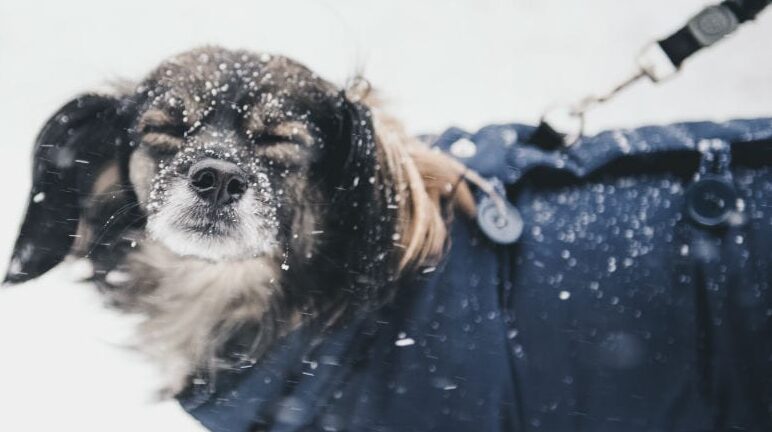Taking Care of Your Dog in Winter

For people who live in seasonal climates – buckle up! Winter is approaching and that means pulling out your warm clothes, weather-proofing the house and making sure the family is ready for the cold months ahead.
If you’re a dog owner, this means taking a few extra steps to ensure that your furry friend is well cared for, too. We have a few tips for ensuring your dog stays warm, healthy and happy this winter.
Protect Your Pup’s Paws
While the pad of a dog’s paws is tougher than our human feet, they are still sensitive to the elements. Consider getting a set of warm booties to protect their paws. Walking your dog in the winter can lead to your dog getting frostbite, especially on their paws. Also, watch out for ice! It can cut your dog’s paws.
Winter paw-protection is also crucial for your metropolitan fur kids. City sidewalks are coated with salt and other deicers in winter. If you don’t want to use booties this winter on your dog, care for their feet after walks by removing any detritus from the outdoors from their paws to avoid the risk of ingesting deicers or other foreign substances.
Limit Time Spent Outside
Even northern sled dog breeds like the Husky and Alaskan Malamute are susceptible to extreme cold and frostbite. It’s best to try and limit the time your dog spends outside in the cold. Short-haired and small dogs will get cold quicker, and young and old dogs are especially at risk because they cannot regulate their body temperature as well.
A warm coat or cover up will prevent shivering and make your dog happier on those necessary trips outside. Walking your dog in the winter for short periods outside will help get them better acclimated to the cold weather, though ensure they have the proper cold-weather dog gear.
Indoor Activities: Treats, Food, and Play!
For dogs who need to mostly stay inside during harsh winters, it can be hard to give them the exercise and entertainment they need. This is when indoor games with your dog come in handy. Hide-n-seek is an excellent game to get your family and dog active. You can play this in two ways. A family member can hide, call for the dog to come find them, and then reward them with a treat. Or, try using toys, treats, or food. Show them their favorite toy/food and close them in another room while you hide it (don’t hide it too well!). Then, release them and ask them to find it. Reward them with a treat every time they find it. You may be surprised at how well their sniffer works!
Not all dogs will get how to play ‘hide-n-seek’ or ‘find it’, so you can bring the game of tug-of-war and fetch inside if you have the space. Food dispensing toys are also a great way to make your dog get active and work for their treats. Winter dog care takes a little extra effort, but it will help keep you busy while cooped up indoors, too.
Protecting Your Pup from Antifreeze
Antifreeze is used in winter to keep your car’s cooling system from freezing, for winterizing houses and RVs, and in some cases for deicing walkways. Antifreeze has a sweet taste that animals like. Just a teaspoonful is enough to give a dog kidney failure. Antifreeze is usually green, but today it is made in a rainbow of colors. Take extra care this winter to ensure your dog does not have access to antifreeze that may have leaked onto the ground. If they show signs of drooling, vomiting, excessive drinking or seizures, seek veterinarian help right away.
And it probably goes without saying, but never leave your dog outside in cold weather for long periods of time, even if he or she seems to be having a blast frolicking in the snow. Remember that dogs are just as susceptible to extreme elements as humans are, so take extra special care of your dog this winter.



